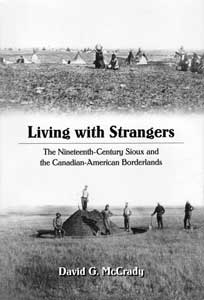by Colin G. Calloway
Dartmouth College
This article was published originally in Manitoba History by the Manitoba Historical Society on the above date. We make this online version available as a free, public service. As an historical document, the article may contain language and views that are no longer in common use and may be culturally sensitive in nature.
Please direct all inquiries to webmaster@mhs.mb.ca.
Help us keep
history alive!David G. McCrady, Living with Strangers: The Nineteenth-Century Sioux and the Canadian-American Borderlands Lincoln: University of Nebraska Press, 2006, 168 pages. ISBN 9780803232501, $45.00 (hardcover).
 Many American historians define their topics, pursue their research, and write their books limited by a border mentality that halts their endeavours at the Rio Grande or the fortyninth parallel. For many Native peoples, however, an international border is a recent phenomenon in their histories, an arbitrary and artificial line that cut across existing tribal spaces, even as it compelled new political arrangements. Understanding Abenaki, Assiniboine, Ojibwa, Blackfoot, or Métis history in the North (or Apache and Yaqui history in the South) requires historians to widen their focus, attempt to write histories that transcend national boundaries, and consider how Native peoples understood, used, and sometimes ignored those boundaries.
Many American historians define their topics, pursue their research, and write their books limited by a border mentality that halts their endeavours at the Rio Grande or the fortyninth parallel. For many Native peoples, however, an international border is a recent phenomenon in their histories, an arbitrary and artificial line that cut across existing tribal spaces, even as it compelled new political arrangements. Understanding Abenaki, Assiniboine, Ojibwa, Blackfoot, or Métis history in the North (or Apache and Yaqui history in the South) requires historians to widen their focus, attempt to write histories that transcend national boundaries, and consider how Native peoples understood, used, and sometimes ignored those boundaries.
David McGrady is not the first historian to take such an approach on the Northwestern Plains. John C. Ewers and Hana Samek both looked north and south of the border in their books on Blackfoot history (John C. Ewers in The Blackfeet: Raiders of the Northern Plains, Norman: University of Oklahoma Press, 1958; Hana Samek, The Blackfoot Confederacy 1880-1920: A Comparative Study of Canadian and U. S. Indian Policy, Albuquerque: University of New Mexico Press, 1987), and Theodore Binnema’s Common and Contested Ground: A Human and Environmental History of the Northwestern Plains (Norman: University of Oklahoma Press, 2001) treats the area as a single bioregion in which diverse communities competed for resources centuries before a border was established. Other authors have written on the Canadian Sioux (James H. Howard, The Canadian Sioux, Lincoln: University of Nebraska Press, 1984; Gontran Laviolette, The Dakota Sioux in Canada, Winnipeg: DLM Publications, 1991). But Living with Strangers makes an important contribution by representing nineteenth century Sioux—the quintessential “American Indians”—as a borderlands people and confirms the growing awareness that "borderland studies" should not be confined to the American Southwest.
Sitting Bull’s escape across the “medicine line” to seek sanctuary in Queen Victoria’s land following the battle of the Little Bighorn is well known. But the Hunkpapa leader’s four-year sojourn in Canada was not a unique event in Sioux history. The Eastern Sioux or Dakotas had a long history of relations with the British; Sioux refugees moved north of the border to escape the American military after the war in Minnesota in 1862 and, like Geronimo’s Chiricahua Apaches who operated between Arizona and Mexico in the 1880s, Sioux bands used the border to their strategic advantage during the wars of the 1870s. Other Indian peoples also crossed and recrossed the poorly manned border to hunt, trade, and visit, and for Métis people the borderlands were homeland.
Recognizing that the border was "open" adds an additional cast of peoples to the kaleidoscope of Dakota and Lakota military, economic and kinship relations. Although McGrady provides more narrative and incident than analysis and interpretation, he creates an effective picture of moving relationships in a time of escalating contests for diminishing resources. Instead of beleaguered refugees, the Sioux in Canada emerge as a people who were at home in the borderland region, creative in their uses of the international line, and active players in exchange and negotiation with other borderland peoples. They traded with the Hudson’s Bay Company as well as with American and traders; they negotiated with agents of both the United States and Canadian governments, and they had to deal with the US cavalry and the Northwest Mounted Police. While they dealt with Crows, Cheyennes, and Pawnees in the South, in the North they dealt with Assiniboines, Ojibwas, Crees, and Blackfoot. Nineteenth-century Sioux, concludes McCrady, “used the boundary both as a shield against oppressive policies and as a gateway to new opportunities.” (p. 6)
The book is grounded in such extensive archival research on both sides of the border and explores such interesting territory (literally as well as figuratively) that one feels a little disappointed at its brevity (114 pages of text). Readers who shell out $45.00 will likely be more disappointed. Nevertheless, this little book has important points to make. Coming on the heels of Beth LaDow, The Medicine Line: Life and Death on a North American Borderland (New York: Routledge, 2001), Sheila McManus, The Line Which Separates: Race, Gender, and the Making of the Alberta- Montana Borderlands (Lincoln: University of Nebraska Press, 2005), and Sterling Evans, ed., The Borderlands of the American and Canadian Wests: Essays on Regional History of the Forty-Ninth Parallel (Lincoln: University of Nebraska Press, 2006), Living with Strangers adds to the growing and welcome attention to northern borderland studies. More importantly, it restores to the Sioux a single coherent history, instead of two separate histories played out on either side of a non-Indian construct.
One Bull, nephew of the Hunkpapa Sioux leader, Sitting Bull, 1882.
Source: Parks Canada Collection, Winnipeg. FN 4.3-21.
Page revised: 15 September 2013